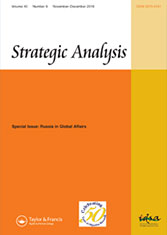Nexus of Global Jihad
The emergence of Al Qaeda on the global stage marked a shift, in more ways than one. Amongst these, it was perhaps the ability to run a corporatised terrorist organisation, with global affiliates who owed allegiance to the mother ship, that set new standards for terrorism. This interlinked global footprint, of not necessarily like-minded organisations, presented a challenge to states, which were neither as quick to adapt, nor as willing to cooperate.
- Vivek Chadha |
- July 2018 |
- Strategic Analysis





